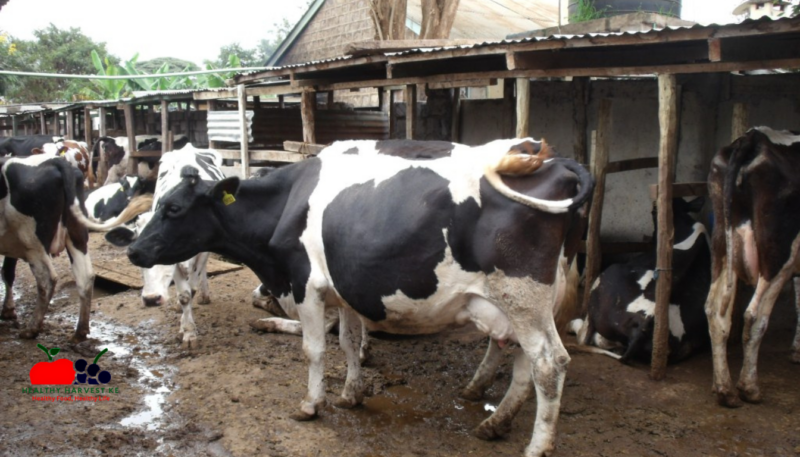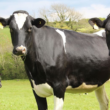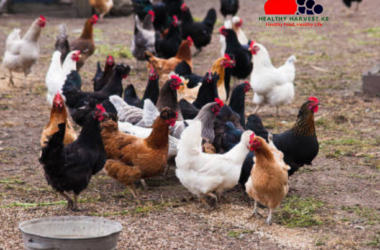Why Zero Grazing Could Be Your Game-Changer
Looking to dive into dairy farming but worried about limited land? Zero grazing might just be your ticket to profitable milk production in Kenya. Unlike traditional open grazing, this system keeps your cows in a specialized housing unit where you bring all feed to them. It’s revolutionizing Kenya’s dairy sector – and for good reason.
The numbers don’t lie. Zero grazing yields approximately 3,300 liters of milk per cow annually, crushing the 2,340 liters you’d get from semi-zero grazing. That’s a whopping 41% increase in productivity, according to research from Egerton University. For new farmers with limited space, this system turns constraints into opportunities.
But it’s not just about more milk. You’ll also see reduced disease spread (especially those nasty tick-borne illnesses), better manure collection for crop production, and more efficient land use. Ready to get started? Let’s break down everything you need to know.
The Historical Success of Zero Grazing in Kenya
Before jumping in, it helps to understand where this system came from. Zero grazing wasn’t just a random trend – it was strategically introduced to address Kenya’s specific farming challenges.
The concept formally arrived in Kenya through the National Dairy Development Project (NDDP) back in 1979 – a joint effort between the Kenyan and Dutch governments aimed at boosting market-oriented milk production. The project introduced a comprehensive dairy farm concept based on confining cattle and implementing a cut-and-carry fodder system.
By 1999, when the project wrapped up, it had reached 25 districts with over 10,000 farmers implementing either full or semi-zero grazing practices. The NDDP developed a complete technology package addressing the main constraints affecting smallholder dairy farming: limited grazing land, low productivity, poor fodder quality, prevalent diseases, and financial limitations.
This structured approach gave farmers a clear framework for success, and many regions adapted it to their specific needs. For instance, in Siaya district, Luo farmers embraced zero grazing not just for milk but also to improve soil fertility for their crops – creating efficient nutrient cycling systems between their dairy and crop operations.
Getting Started: The Essential Components
Ready to set up your zero grazing unit? Here’s what you’ll need to get right from day one:
1. Housing Design and Setup
Your housing unit is the heart of zero grazing. It needs to be functional, comfortable for your cows, and designed for easy management. Here’s what to include:
- Concrete floor with slight slope: Facilitates cleaning and drainage
- Covered feeding area: Protects feed from rain and sun
- Resting area with soft bedding: Ensures cow comfort
- Walking area: Allows limited movement for exercise
- Milking section: Clean, dedicated space for milking
- Water troughs: Constant access to clean water
- Waste collection system: Channels for manure collection
The standard unit should provide at least 4-5 square meters per cow. Position your unit to maximize natural ventilation while providing adequate shade. Remember, your cows will spend all their time here, so invest in proper construction from the start.
2. Choosing the Right Dairy Cows
Your production success hinges significantly on your choice of cows. The NDDP recommends high-yielding graded dairy cows with more than 50% exotic blood. Consider these breeds:
- Friesian: Highest milk producers but require excellent management
- Ayrshire: Good producers, more disease-resistant than Friesians
- Jersey: Smaller size, rich milk, good for smaller spaces
- Guernsey: Adaptable, good milk fat content
- Sahiwal: Heat-tolerant, good for crossbreeding with local breeds
For beginners, starting with 1-2 quality cows is better than multiple lower-quality animals. Look for cows that are already producing milk or pregnant heifers close to calving from reputable farmers or breeding centers.
3. Feed Management: The Make-or-Break Factor
In zero grazing, you’re 100% responsible for your cows’ nutrition – no grazing to supplement their diet. Getting this right is crucial.
Forage Production
Napier grass should be your primary fodder crop. Here’s what you need to know:
- Plant approximately 0.75 acres of Napier grass per mature cow and her offspring
- Cut when it reaches 60-90 cm height for optimal nutrition
- Maintain multiple plots with staggered planting to ensure year-round supply
- Supplement with other forages like sweet potato vines, lucerne, or desmodium
Feeding Schedule and Requirements
A consistent feeding regimen is vital. Constant changes confuse the microorganisms in the cow’s digestive system, reducing efficiency. A typical daily requirement for a mature dairy cow includes:
- 70-80 kg of fresh Napier grass (or equivalent forage)
- 2-3 kg of protein-rich supplements (dairy meal, sunflower cake, etc.)
- Mineral supplements (salt licks or mineral blocks)
- 40-50 liters of clean water
Feed frequency matters too – aim for at least three feeding times per day with consistent timing.
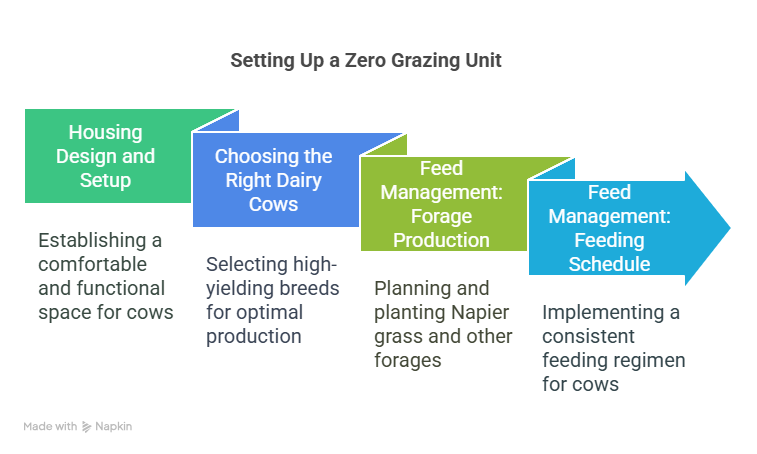
Turning Challenges into Opportunities
Every farming system has its challenges. For zero grazing, these typically include:
1. Labor Requirements
Zero grazing is labor-intensive. You’ll need dedicated help for:
- Cutting and carrying fodder daily
- Cleaning the unit
- Milking twice daily
- Monitoring animal health
Solution: Start small and expand gradually. Consider semi-automation for routine tasks like water provision. Create efficient workflows to minimize wasted effort.
2. Initial Investment Costs
Setting up a proper zero grazing unit requires upfront capital for:
- Housing construction
- Quality dairy cows
- Feed establishment
- Equipment (milking, storage, etc.)
Solution: Begin with a basic but functional unit that can be expanded later. Consider cooperative ownership of expensive equipment like chaff cutters. Explore agricultural financing options specifically designed for dairy ventures.
3. Knowledge Gap
Studies in regions like Bondo Sub-County show that knowledge gaps about successful zero-grazing practices limit adoption. Zero grazing requires specific technical knowledge about:
- Animal nutrition
- Disease prevention
- Reproductive management
- Milk handling
Solution: Leverage extension services, attend dairy farming workshops, join farmer groups, and connect with successful zero grazing farmers. Knowledge is your most valuable asset.
Financial Planning: Making Your Numbers Work
Before diving in, let’s talk money. Here’s a simplified breakdown of what to expect:
Initial Investment (Kenyan Shillings)
| Item | Estimated Cost (KES) | Notes |
|---|---|---|
| Basic housing unit for 2 cows | 150,000-300,000 | Varies based on materials and design |
| High-quality dairy cow | 80,000-150,000 | Per cow, depending on breed and production status |
| Napier grass establishment (0.75 acre) | 15,000-25,000 | Per cow, including land preparation and planting |
| Basic equipment | 30,000-50,000 | Includes milk cans, chaff cutter, buckets, etc. |
| Total initial investment | 275,000-525,000 | For starting with one cow |
Monthly Operating Costs (2-cow operation)
| Expense | Estimated Monthly Cost (KES) | Notes |
|---|---|---|
| Feed supplements | 8,000-12,000 | Dairy meal, minerals, occasional concentrates |
| Labor | 5,000-10,000 | Part-time help for cutting feed and basic operations |
| Veterinary care | 2,000-4,000 | Routine checkups, vaccinations, deworming |
| Miscellaneous | 3,000-5,000 | Transport, maintenance, etc. |
| Total monthly expenses | 18,000-31,000 |
Potential Monthly Revenue (2-cow operation)
| Income Source | Estimated Monthly Income (KES) | Notes |
|---|---|---|
| Milk sales | 45,000-60,000 | Based on 15-20L per cow daily at KES 50 per liter |
| Manure | 2,000-4,000 | Either used on own crops or sold |
| Total monthly income | 47,000-64,000 |
Potential monthly profit: KES 29,000-33,000
Remember, these are estimates. Your actual costs and returns will vary based on management, location, and market conditions. The key takeaway? Zero grazing can be profitable, but requires careful financial planning and management.
Best Practices for New Zero Grazing Farmers
Want to maximize your chances of success? Follow these proven strategies:
1. Start Small, Scale Smart
Begin with 1-2 quality cows rather than many mediocre ones. This allows you to:
- Learn the system with lower risk
- Perfect your management before scaling up
- Reinvest profits into expansion
- Avoid overwhelming labor requirements
2. Focus on Genetics and Breeding
Your herd quality determines your profitability. Invest in:
- Artificial insemination with semen from proven dairy bulls
- Proper heat detection and timing
- Record keeping of breeding dates and outcomes
- Strategic culling of low performers
3. Disease Prevention Over Treatment
In confined systems, disease prevention is crucial:
- Maintain strict cleanliness in housing
- Implement regular vaccination schedules
- Watch for early signs of mastitis
- Practice proper tick control even though cows are confined
- Consult regularly with a veterinarian
4. Create Efficient Feed Systems
Research shows that feed management directly impacts production:
- Establish a year-round fodder production system
- Learn to make silage for dry season feeding
- Use chaff cutters to improve digestibility
- Grow protein-rich fodder supplements on farm
- Establish water delivery systems that minimize labor
5. Build Market Relationships Early
Don’t wait until you have milk to find buyers:
- Connect with local dairy cooperatives
- Explore direct marketing to nearby businesses
- Consider value addition (yogurt, mala) for better returns
- Build a reputation for consistency and quality
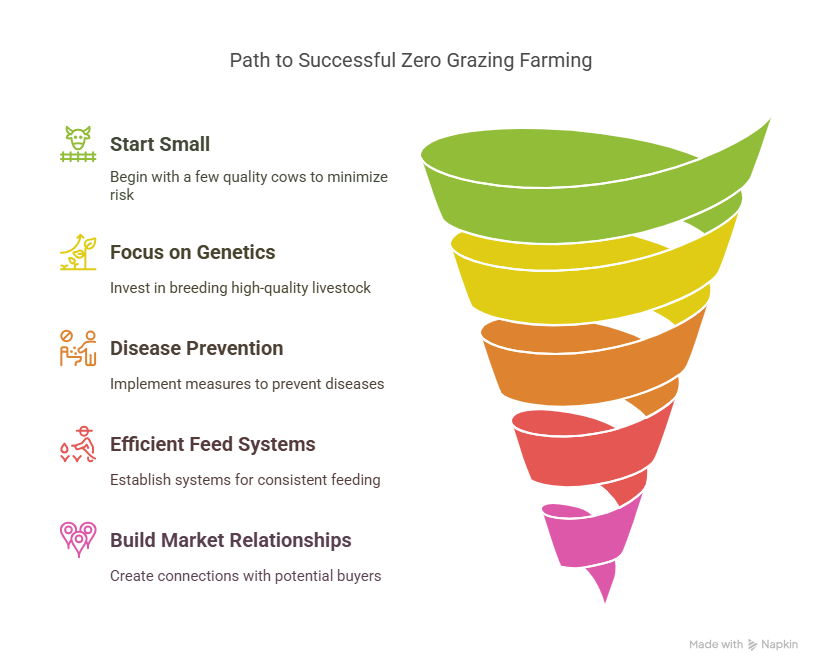
Common Mistakes to Avoid
Learn from others’ errors to shortcut your success:
- Overcrowding: Cramming too many cows into limited space leads to stress, reduced production, and increased disease.
- Feed inconsistency: Sudden changes in feed type or quantity cause digestive upset and production drops.
- Inadequate water: Dairy cows need 40-50 liters of clean water daily – insufficient supply dramatically reduces milk production.
- Poor record keeping: Without proper records of breeding, production, and health, you can’t make informed management decisions.
- Neglecting cow comfort: Uncomfortable cows produce less milk. Proper bedding, ventilation, and protection from weather extremes are essential investments.
Conclusion: Your Next Steps
Zero grazing dairy farming offers incredible potential for new Kenyan farmers facing land constraints. With significantly higher milk yields than traditional systems, better disease control, and efficient resource use, it represents a smart entry point into commercial dairy production.
Remember that success in zero grazing comes from attention to detail – housing design, cow selection, consistent feeding, and preventative health care all work together to determine your outcomes. Start small, learn continuously, and scale gradually.
Ready to get started? Your next steps should be:
- Visit established zero grazing farms to see real-world operations
- Connect with your local agricultural extension office for specific guidance
- Develop a detailed business plan with realistic projections
- Start establishing your fodder production before purchasing animals
- Build your network of veterinary and market connections
The path to successful zero grazing isn’t always easy, but for thousands of Kenyan farmers, it’s proven to be worth the effort. With careful planning and implementation, you could be joining their ranks as a profitable dairy entrepreneur.
Have you already taken steps toward starting a zero grazing operation? What challenges are you facing? Share in the comments below!




